Standing on the ground and looking up, we admire the vastness of the universe. However, the distant stars are merely tiny bright dots lost in a sea of celestial bodies filled with mysteries that the naked eye cannot measure.
In 1609, the Italian scientist Galileo Galilei used a telescope to gaze into the sky, witnessing celestial bodies floating (at that time, he did not know it was Jupiter’s moons) that were not orbiting Earth. This marked the beginning of a new chapter in astronomy: We are not the center of the universe.
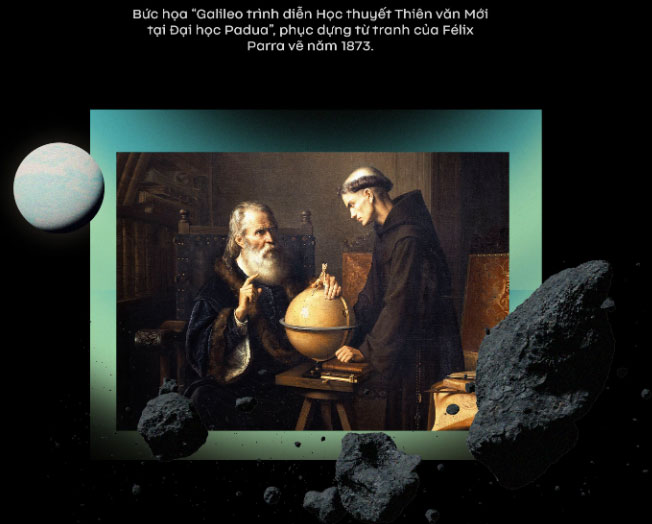
Nearly four centuries after Galileo illuminated humanity, the National Aeronautics and Space Administration (NASA) and the European Space Agency (ESA) collaborated to launch the Hubble Space Telescope, once again opening a new chapter in the encyclopedia of the universe, which still holds many mysteries.
By extending our gaze beyond the atmosphere that distorts light signals from the universe, Hubble initiated a new revolution in astronomy. No longer hindered by the atmosphere that blurred the stars and blocked wavelengths of light rich in knowledge, this advanced telescope system observed celestial objects and strange phenomena in unprecedented detail.
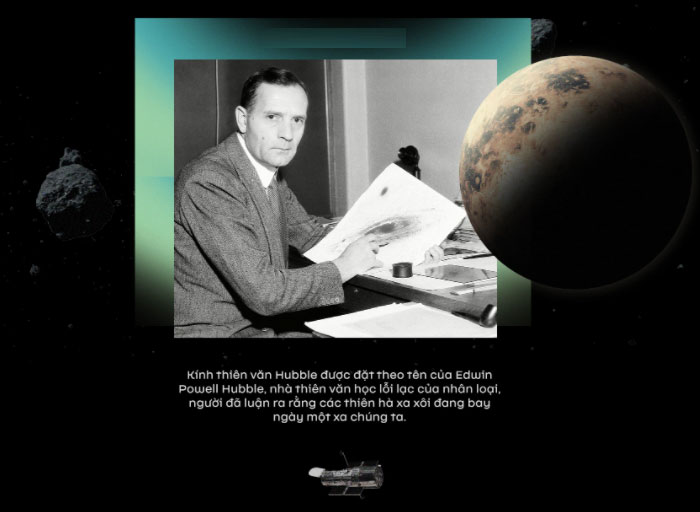
From an altitude of 547 km above the Earth’s surface, sensitive cameras and modern spectrometers can observe tiny asteroids nearby while also capturing distant galaxies nurturing newly formed stars. Hubble has the capability to continuously observe a patch of sky, striving to gather every bit of light to see as far as possible.
The results obtained have changed our most fundamental understandings of the vast universe.
Breakthroughs from the Hubble Telescope
Named after Edwin Powell Hubble (1889-1953), the space telescope launched on April 24, 1990, has been operational for over 31 years. Just as Edwin Hubble laid the groundwork for extragalactic astronomy and observational cosmology, the Hubble Telescope has brought about a series of breakthroughs after many years of service.
Hubble has completed over a million space observation projects, laying the groundwork for researchers to successfully publish more than 18,000 scientific papers on countless topics, from planet formation to studies of supermassive black holes. These scientific reports have been cited over 900,000 times; on average, the scientific community references Hubble’s achievements about 150 times a day.
This number continues to grow as Hubble remains active at the age of 31. But before we await Hubble’s new valuable data, let’s review the 10 most notable achievements.
A Universe Expanding in All Directions
About a century ago, Edwin Hubble measured the rate of expansion of the universe. This value is known as the “Hubble Constant”, one of the key metrics used to determine the age, size, and future fate of the billions-of-years-old universe. Before the Hubble Telescope was launched, the value of the Hubble Constant was inaccurate, leading to estimates of the universe’s age ranging from 10 to 20 billion years.
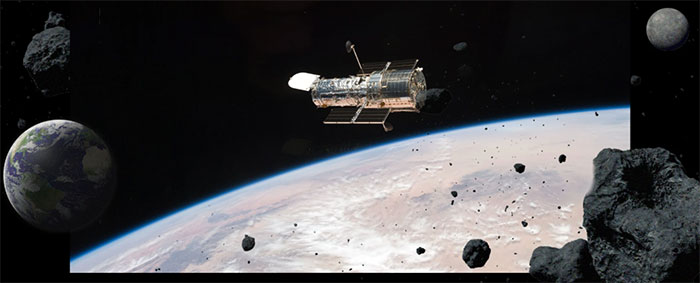
However, when advanced observational equipment refined the Hubble Constant to its purest form, estimates of the universe’s expansion rate became increasingly accurate. Scientists achieved this by using data from distant galaxies with greater precision and combining it with measurements of galaxy velocities from other instruments beyond Hubble.
Researchers measure distances by comparing the brightness of a known celestial object in a galaxy (like a star or a newly exploded star) with a similar object in the distance. With increasingly accurate figures provided by Hubble, calculations show that the “young” universe was born about 13.8 billion years ago.
Thanks to Hubble, scientists faced an astonishing discovery: by combining data from both space and ground-based telescopes, they found that the universe is not only expanding in all directions but that the rate of expansion is accelerating. This discovery was honored with a Nobel Prize in Physics awarded in 2011.
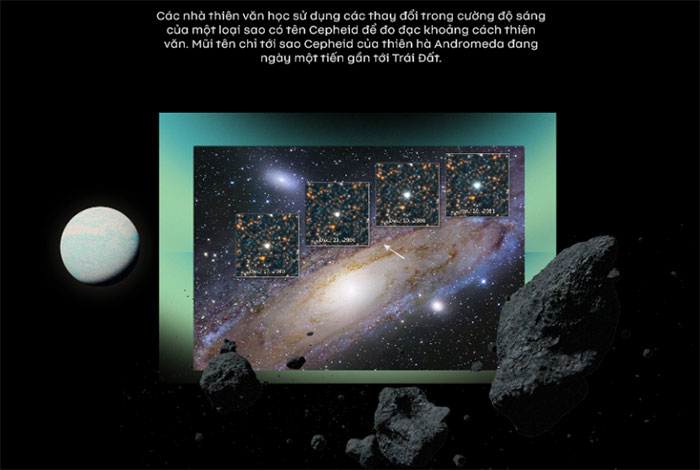
Many scientists believe that the increasing rate of expansion is caused by “dark energy,” a “repulsive force” thought to account for 70% of the mass and energy in the universe, but no device has yet been able to detect it.
Even though it cannot be measured directly, scientists can indirectly quantify dark energy by observing how it interacts with matter in the universe. By studying the behavior of dark energy, astronomers believe they can understand its nature and its impact on the future of the universe.
“Observing” the Unobservable: Dark Matter
Dark matter is an invisible form of matter that constitutes the majority of the universe’s mass and simultaneously builds the structure that supports the universe. The gravitational pull of dark matter causes ordinary matter (dust and gas in space) to accumulate into stars and galaxies. Although we cannot (or at least have not yet been able to) see dark matter, we can determine its influence by observing the gravitational forces of massive galaxy clusters containing dark matter; light emitted from galaxies hidden behind these strange masses is bent and distorted.
Scientists refer to this phenomenon as “gravitational lensing.”
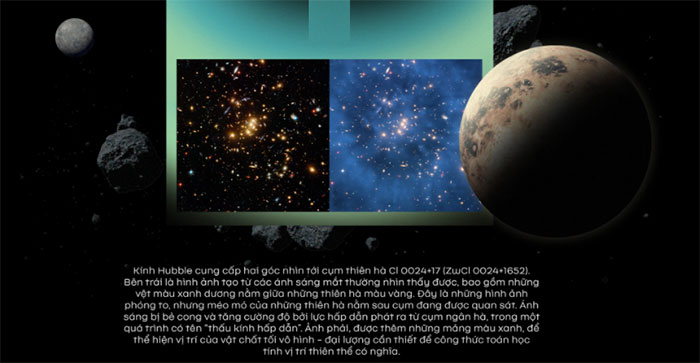
Through the phenomenon of gravitational lensing, the keen eye of the Hubble Telescope allows scientists to map the distribution of dark matter in the universe. By observing the space around large galaxy clusters containing both dark and ordinary matter, they can identify the distorted images of galaxies and reverse them to pinpoint where dark matter is most concentrated.
Mathematical models will deduce the locations and characteristics of the materials causing the light-bending effect. According to calculations, the amount of dark matter is estimated to be five times that of ordinary matter, and the universe we know is built around a network of dark matter filaments extending in all directions. At the intersections of these filaments, we see the existence of enormous visible structures, such as galaxy clusters.
Tracking the Growth of Galaxies
Using the Hubble Telescope, scientists have captured numerous images showing the shapes of galaxies at various stages of development. This breakthrough is made possible by the mathematical relationship between distance and time in the universe: the deeper Hubble looks into space, the older light it captures, thus peering further back into the past. The farthest and oldest galaxies ever observed by Hubble are small and display many unusual shapes compared to the spiral and elliptical forms we are familiar with. This evidence indicates that galaxies grow through mergers with other galaxies, eventually forming the large galaxy systems we see today.
As the size of the universe in the past was relatively “modest,” galaxies were likely close enough to interact with each other through gravitational forces. The images captured by Hubble reveal the existence of stellar streams (a collection of stars that were once part of a galaxy but may have been ejected after a collision between two galaxies).
Over time, these stellar streams stabilize their positions in space, being thrown closer to Earth and thus moving nearer to the present moment. By studying galaxies from different epochs, astronomers can track how a galaxy changes and evolves over time. Additionally, we have data on the number of stars and gas present in the galaxy, as well as the detection of existing chemical elements and the star formation rate.
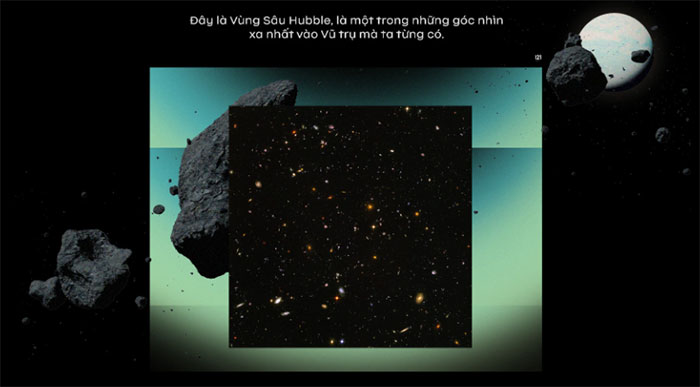
Galaxies continue to evolve over time. Observing our “neighbor” galaxy, Andromeda, has allowed scientists to predict accurately what will happen: in 4 billion years, the Milky Way and Andromeda galaxies will collide. Andromeda is located 2.5 billion light-years away from us but is gradually moving closer due to the gravitational influence between the two galaxies, as well as the effect of dark matter enveloping both Andromeda and our galaxy.
In many billions of years, the Milky Way and Andromeda galaxies will merge, forming a giant elliptical galaxy.
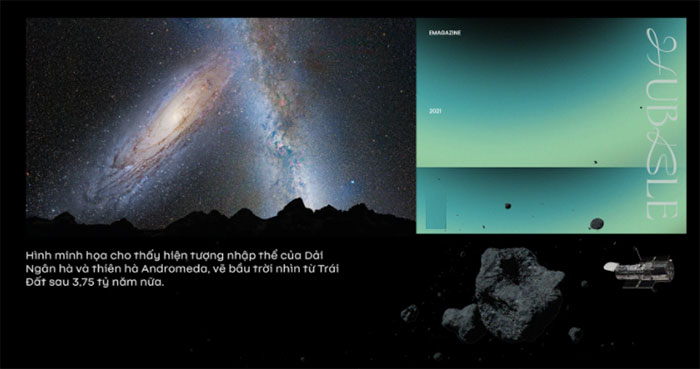
Realizing That Supermassive Black Holes Are Everywhere
Hubble has discovered decisive evidence showing that most galaxies possess a supermassive black hole, with masses millions to billions of times that of stars. Moreover, the size of these black holes is proportional to the size of their host galaxies.
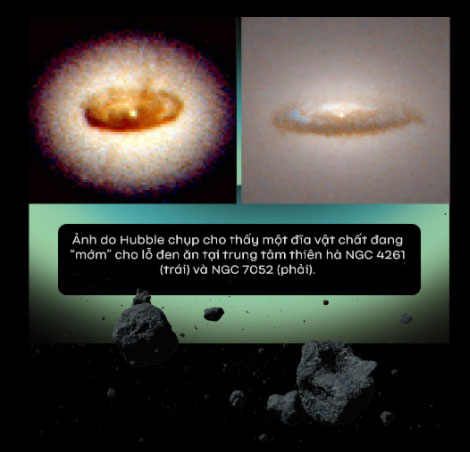
Data from the Hubble Space Telescope shows that the mass of a black hole is dependent on the mass of the stars present in its central region. This correlation provides evidence that black holes grow in tandem with galaxies, absorbing a portion of the galaxy’s mass into their bottomless voids.
Hubble has also provided the first images showing matter swirling around black holes, forming massive accretion disks, and capturing jets of subatomic particles ejected from black holes at speeds approaching that of light.
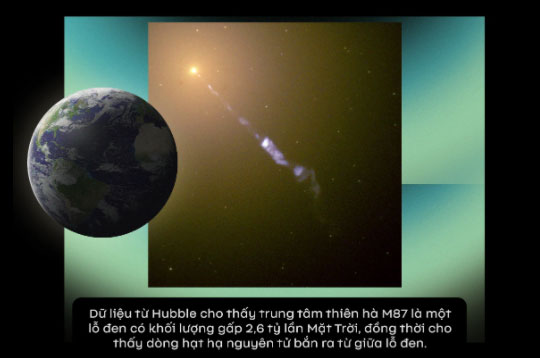
Analyzing Exoplanets
Before the Hubble Space Telescope was launched into space, researchers had not discovered any planets outside the Solar System. Currently, astronomers have identified the existence of over 4,000 exoplanets beyond the Sun’s influence, most of which were discovered by NASA’s Kepler Space Telescope and various ground-based observatories. Hubble has also contributed significantly to this field.
Astronomers used Hubble to measure the composition of the atmospheres of exoplanets for the first time. We now know that the atmospheres of these distant worlds can contain sodium, oxygen, carbon, hydrogen, carbon dioxide, methane, and water vapor. Most of the observed celestial bodies are too hot to support life as we know it. However, Hubble’s observations have revealed that essential elements for life are present on planets orbiting stars.
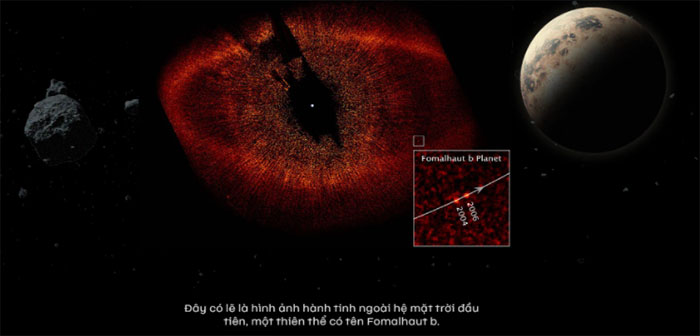
Hubble’s ultraviolet capabilities can penetrate the thick hydrogen clouds emitted by planets orbiting stars. Due to radiation from the central star, hydrogen in the atmosphere of a Neptune-sized planet evaporates. This phenomenon may explain the existence of barren “super-Earths”; the radiation has also left the surfaces of these planets rocky and rugged.
Using a technique known as gravitational microlensing, astronomers can identify planets orbiting a binary star system. Microlensing occurs when the light from a star is bent by the gravitational pull of the companion star.
From these characteristics, researchers can infer the nature of the binary stars and subsequently analyze the properties of the planets orbiting them.
Discovering Planet Formation Regions
Astronomers assert that planets form from the accretion disks of cosmic dust surrounding a star. Hubble was the first telescope to provide clear images of accretion disks around nearly 200 stars in the Orion constellation. After gathering data from other star systems, Hubble compiled the largest and most detailed survey dataset of these material disks, likely formed from collisions between celestial bodies during the planet formation process.
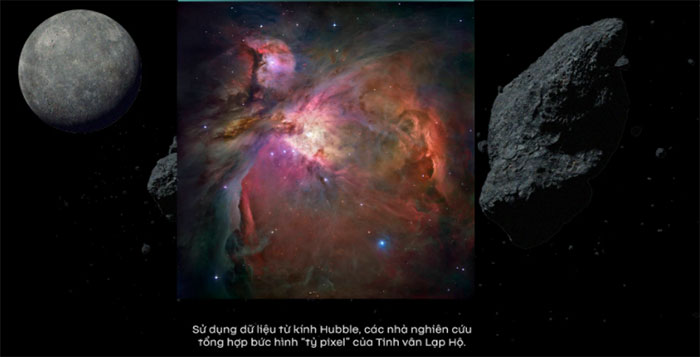
Exploring Star Formation Processes
Hubble’s infrared sensors have been able to peer through enormous clouds of gas and dust, witnessing tens of thousands of stars being born. Observing nebulae of unimaginable sizes, Hubble has captured a strange landscape sculpted by the radiation from young, bright stars.
Observations reveal a vigorous star formation process, generating powerful ultraviolet radiation and far-reaching space vibrations. This radiation creates voids in the star-forming clouds, eroding material in the colossal gas columns that serve as “nurseries” for new stars.
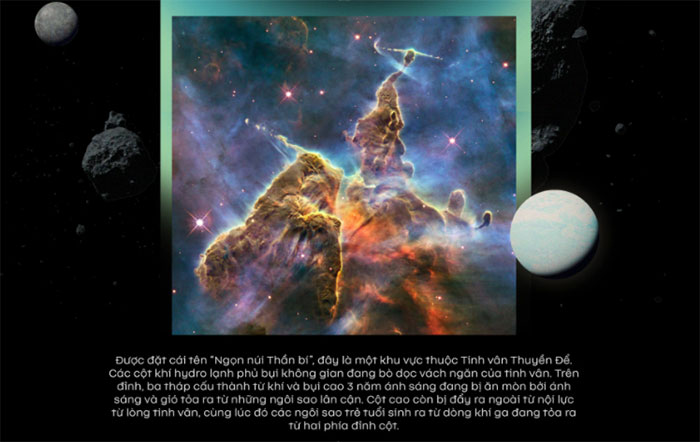
Hubble has also captured unprecedented details of gas jets emitted from young stars. These jets are byproducts formed when gas is drawn into newly forming stars, shaped by magnetic fields and ejected from the star’s poles in opposite directions.
Thanks to its long research history, Hubble has been able to observe movements and changes over time, synthesizing the star formation process while identifying the unique environment surrounding a newly formed star.
Documenting the Death of Stars
The Hubble Telescope has captured unprecedented details about the deaths of Sun-like stars. Images obtained from ground-based telescopes show hazy clusters, referred to as “planetary nebulae” (though the term has nothing to do with planets), typically taking on a simple spherical shape.
Hubble has debunked this misconception.
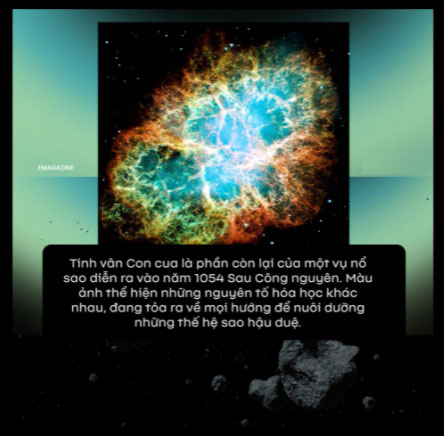
It turns out that the death of a star is diverse and complex. Some nebulae resemble spirals, others take the form of hourglasses, while some appear like gigantic cosmic butterflies. This diversity illustrates how a star expels its gaseous outer layers to “collapse” into a white dwarf.
Looking at the remnants left after a star’s “funeral,” Hubble has provided valuable data related to the supernova explosion SN 1987A: three mysterious rings of material encircling a deceased star. The telescope has also observed bright spots on the inner edge of the middle ring, created by shockwaves of material colliding during the explosion.
Capturing Details of Galaxies and Merging Events
When astronomer Edwin Hubble discovered that the universe contained a plethora of galaxies beyond the Milky Way, he classified them into three main categories: spiral, elliptical, and irregular. Later, the telescope named after him provided clear images that validated his observations from years past.
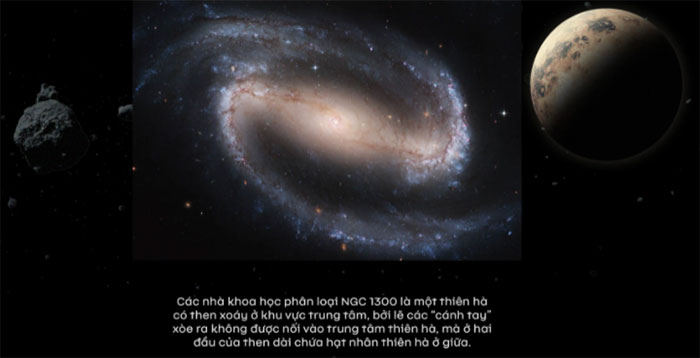
Moreover, the images captured by Hubble have uncovered countless strange shapes of galaxies. The further back in time we look, the more diverse the shapes of galaxies appear. At this time, the universe is still expanding and was “young” billions of years ago, with galaxies still close together, allowing for significant interactions.
Hubble has captured moments of small galaxies interacting at various stages. The merging of two galaxies creates waves and significant disturbances in the order of matter, leading to the formation of numerous new stars in the interstellar dust clouds.
Images from the past somewhat predict events four billion years into the future when the Milky Way and the Andromeda galaxy face an unavoidable merging event.
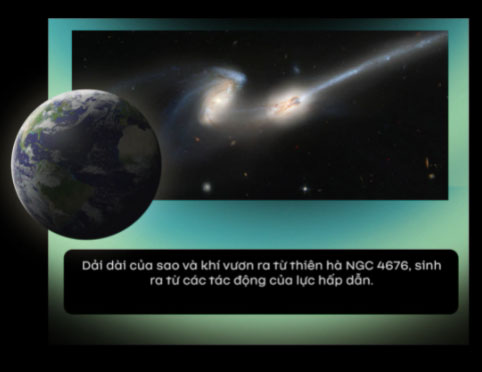
Observing “Light Echoes”
Hubble has witnessed the phenomenon of light echoes in space, generated by the explosion of a star.
In January 2002, from the region of space containing a red supergiant star, a sudden burst of light appeared, leaving a “bubble” of debris expanding in all directions. In fact, the flash emanated from the glowing cloud surrounding the star. Because light travels at a finite speed, the flash took years to reach distant regions of space, tracing the structure of the celestial bodies it encountered, from dust clouds to large planets. This phenomenon is termed “light echo,” akin to describing how sound travels along a canyon, detailing every rugged point of the steep cliffs.
Light Echo Phenomenon
The red star associated with the light echo phenomenon is a peculiar supergiant known as V838 Monocerotis, located about 20,000 light-years from Earth. During its explosion, the star shone 600,000 times brighter than the Sun. This event likely occurred due to V838 Monocerotis absorbing another star or celestial object. Surrounding the red star are vast voids devoid of cosmic dust, resembling gaps in a sticky cheese.
Light echoes frequently occur around supernova explosions; however, V838 Mon did not explode by itself, and its flash appears to be unique, becoming yet another mysterious phenomenon of the universe.
Hubble is Still Young and has More to Offer
The long list above is the result of 31 years of data collection and research synthesis from various telescope systems (both optical and radio) around the globe. However, with the advantage of being a “standout” instrument, Hubble has achieved breakthroughs that have changed human understanding.
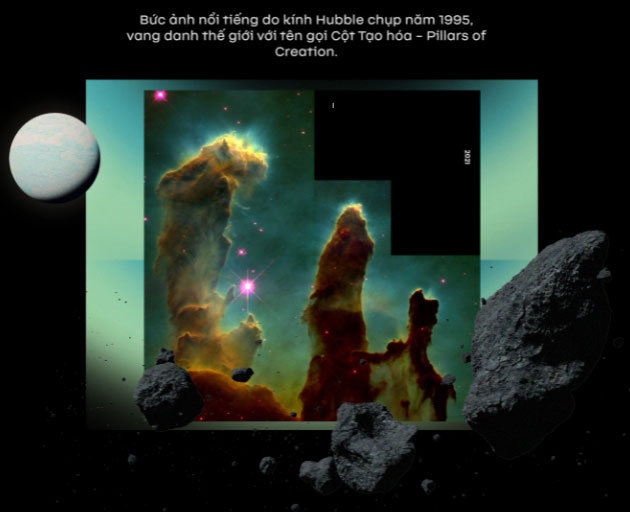
However, every magnificent king must eventually abdicate. In these final days of 2021, we witness humanity’s new technological marvel entering orbit; the “prince” of space telescopes, the James Webb Space Telescope, will assist Hubble in continuing its reign, learning from its predecessor while awaiting the day it takes on the grand mission itself.
It is expected that Hubble will remain in service until 2030-2040. With the added power from the James Webb Space Telescope set to launch, Hubble will continue to provide valuable research data. Retirement is still far off; for now, it remains a time of contribution to the great endeavor.


















































